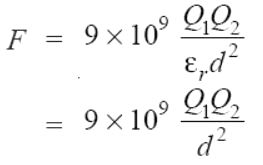Laws of Electrostatics
First Laws of Electrostatics :
Like charges of electricity repel each other, whereas unlike charges attract each other.
Second Laws of Electrostatics :
According to this law,
the force exerted between two point charges (i) is directly proportional to the product of their strengths (ii) is inversely proportional to the square of the distance between them.
This law is known as Coulomb’s Law and can be expressed mathematically as :

In vector form, the Coulomb’s law can be written as

where ![]() is the unit vector i.e. a vector of unit length in the
is the unit vector i.e. a vector of unit length in the
direction of distance d, i.e.
![]()
(where ![]() is the vector notation for d, which is a scalar notation). Therefore, explicit forms of this law are :
is the vector notation for d, which is a scalar notation). Therefore, explicit forms of this law are :

where ![]() is the force on Q2 due to Q1 and
is the force on Q2 due to Q1 and ![]() is the unit vector in direction from Q1 to Q2 and
is the unit vector in direction from Q1 to Q2 and

where F12 is the force on Q1 due to Q2 and ![]() is the unit vector in the direction from Q2 to Q1. Where k is the constant of proportionality, whose value depends on the system of units employed. In S.I. system, as well as M.K.S.A. system k = 1/4πε. Hence, the above equation becomes.
is the unit vector in the direction from Q2 to Q1. Where k is the constant of proportionality, whose value depends on the system of units employed. In S.I. system, as well as M.K.S.A. system k = 1/4πε. Hence, the above equation becomes.

If Q1 and Q2 are in colomb, d in metre and ε in fard/metre, then F is in newtons
Now  8.9878 109 9 109 (approx.)
8.9878 109 9 109 (approx.)
Hence, Coulomb’s Law can be written as


If in Eq. (i) above
Q1 = Q2 = Q (say), d = 1 metre;
F = 9 × 109 N
then Q2 = 1 or Q = ± 1 coulomb
Hence, one coulomb of charge may be defined as that charge (or quantity of electricity) which when placed in air (strictly vacuum) from an equal and similar charge repels it with a force of 9 × 109 N. Although coulomb is found to be a unit of convenient size in dealing with electric current, yet, from the standpoint of electrostatics, it is an enormous unit.
Hence, its submultiples like micro-coulomb (μ C) and micro-microcoulomb (μ μC) are generally used. 1 μ C =10−6 C; 1 μ μ C = 10−12 C
It may be noted here that relative permittivity of air is one, of water 81, of paper between 2 and 3, of glass between 5 and 10 and of mica between 2.5 and 6.
Read article – Units of Resistivity
Visit NCERTplanet.com for NCERT solutions and Textbook downloads

